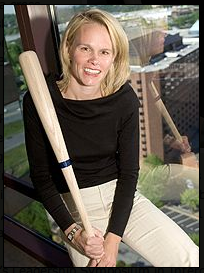Molly Fletcher's Blog, page 16
September 26, 2016
7 Fresh Ways to Ask for What You Want
 We all find ourselves in situations daily where we have to ask for what we need and want. Maybe it’s needing a colleague’s help with a project, approaching a conversation with your boss, or even asking a small favor of a complete stranger.
We all find ourselves in situations daily where we have to ask for what we need and want. Maybe it’s needing a colleague’s help with a project, approaching a conversation with your boss, or even asking a small favor of a complete stranger.
What helps are fresh ways to ask so you will get what you need. Here are some of my favorites and why they work. Remember, tone and timing matter too, so make your ask projecting humility, confidence and respect.
1. How great will it be when…?
Vivid imagery is a powerful way to help yourself and others achieve your goals. This phrase breathes life into the team’s mission with a lot of positive emotion.
2. Is it hard for you to…?
Curiosity-based teamwork and leadership grows through consistent pursuit of authentic conversations and observations. Everyone is different, and it’s important to ask questions to gain clarity on strengths and weaknesses. Use compassion with this phrase to help colleagues get unstuck.
3. I’m thinking you can make this happen….?
This wording is so effective for people who lack confidence or may even be experiencing the impostor syndrome. You are telegraphing faith in them and affirmation that they are well-matched to what is requested.
4. You got juice to make this happen….
Not every ask needs to be a question. Mix it up. A cheerful statement like this that projects confidence in the person’s ability to deliver. Humor can speed up and solidify connections with others.
5. What if….
These two words aren’t just hypothetical. They signal creativity and boldness. These words are very motivational to creative thinkers who like to challenge the status quo.
6. You would be my hero if….
This is the essential call to action. For greatest effectiveness, keep it simple, specific and urgent.
7. Let’s do this…
Harness the power of the simple three-word message to convey that the entire team is behind (and dependent on) individual efforts.
Your Game Changer Takeaway
Fresh language helps keep the ask alive and vibrant. Don’t get stuck in a rut asking others for what you need and want. If you’ve got a phrase to share that works for you, let’s keep this conversation going on social media @mollyfletcher on Twitter!
Molly Fletcher competed for Michigan State’s women’s tennis team and is raising three daughters who play sports. She works to inspire and equip game changers to dream, live and grow fearlessly.A keynote speaker and author, Molly draws on her decades of experiences working with elite athletes and coaches as a sports agent, and applies them to the business world. Her e-learning courses spark both personal growth for individuals and corporate development for organizations. Sign up here to receive our monthly newsletter.
The post 7 Fresh Ways to Ask for What You Want appeared first on Molly Fletcher.
September 19, 2016
What Each Decade of My Life Has Taught Me
Once a year (usually around my birthday), I like to look back at what I have learned (sometimes the hard way!) that has helped me learn fearlessness and now find a way to spark it in others. Confronting our fears is such a big key to pursuing purpose, meaning and productivity in our lives.
As I anticipate the year and decade ahead, I want to share a shortcut to help you achieve greater fearlessness.
It’s so important to trade your old story (what you tell yourself that limits your best self) for your new story, and adopt the new behaviors and rituals of greater fearlessness. By cherry-picking the most meaningful lesson from each decade of your life, you likely will have a greater sense of how you have learned to deal with fear.
Here’s how this works as I reflect on my life.
Age birth to 10: You can figure it out.
 My twin brothers are five years older than me, and on the first day of school, our working Mom asked them to walk me to my kindergarten class and get me settled. The side door to the classroom wasn’t open because the teacher hadn’t arrived yet. “She’ll be here in a minute, just wait here,” my brothers told me. They were out of there! About 10 minutes later the door finally opened, and I found my way around. It was scary to be left alone in a new place at a young age. This memory reminds me that sometimes you are stuck by yourself and you have to figure it out.
My twin brothers are five years older than me, and on the first day of school, our working Mom asked them to walk me to my kindergarten class and get me settled. The side door to the classroom wasn’t open because the teacher hadn’t arrived yet. “She’ll be here in a minute, just wait here,” my brothers told me. They were out of there! About 10 minutes later the door finally opened, and I found my way around. It was scary to be left alone in a new place at a young age. This memory reminds me that sometimes you are stuck by yourself and you have to figure it out.
Age 11 to 20: Prepare for opportunity before it arrives.
 I applied to Michigan State University and several smaller liberal arts schools. I remember getting the big envelope from MSU with my acceptance letter… along with the rejection letters from the others. I made the decision to walk on to the MSU tennis team—which meant no scholarship money and likely little playing time. I worked my tail off my senior year of high school and the summer before college, ready to contribute in whatever way I could to the team. A few months into the school year, several injuries left the team shorthanded. Before I knew it, I was thrust into the lineup playing #1 doubles and #6 singles. That experience and preparation gave me the confidence I needed and I earned a partial scholarship my sophomore year and captained the team as a senior. The lesson I learned is to always prepare like your number will be called. You never know when it will be!
I applied to Michigan State University and several smaller liberal arts schools. I remember getting the big envelope from MSU with my acceptance letter… along with the rejection letters from the others. I made the decision to walk on to the MSU tennis team—which meant no scholarship money and likely little playing time. I worked my tail off my senior year of high school and the summer before college, ready to contribute in whatever way I could to the team. A few months into the school year, several injuries left the team shorthanded. Before I knew it, I was thrust into the lineup playing #1 doubles and #6 singles. That experience and preparation gave me the confidence I needed and I earned a partial scholarship my sophomore year and captained the team as a senior. The lesson I learned is to always prepare like your number will be called. You never know when it will be!
Ages 21-30: Ask for advice.
 After college, I moved to Atlanta with the names of three people who I thought might be able to help me. Not with a job directly, but advice on getting a job. These three strangers listened to my questions and each referred me to three other people they knew who might be able to help me, and so on. As I met people who were doing what I wanted to do, I eventually began doing the job myself. Asking for advice is all about tapping into your curiosity, and that fuels connection. Staying curious and seeking advice from anyone I could was ultimately how I broke into the sports industry. Never be afraid to ask for advice, and stay curious.
After college, I moved to Atlanta with the names of three people who I thought might be able to help me. Not with a job directly, but advice on getting a job. These three strangers listened to my questions and each referred me to three other people they knew who might be able to help me, and so on. As I met people who were doing what I wanted to do, I eventually began doing the job myself. Asking for advice is all about tapping into your curiosity, and that fuels connection. Staying curious and seeking advice from anyone I could was ultimately how I broke into the sports industry. Never be afraid to ask for advice, and stay curious.
Ages 31-40: Connect with your why.
 At age 29 I got married, at 31, we had our first daughter, and the next year welcomed twins. My daughters taught me a love like I never knew existed. I’ve never loved like I do now toward them. That transcendent emotion—and the speeded-up sense of time that comes with parenting and age—compelled me to connect even more on my why. Connecting with my purpose powered me to make the jump from being a sports agent to author and speaker. Becoming a mother of three practically overnight certainly hastened my clarity on my purpose and immediately brought me new perspective. No better time than the wee hours of the morning—both exhausted and madly in love—to dig deep inside and connect to your why.
At age 29 I got married, at 31, we had our first daughter, and the next year welcomed twins. My daughters taught me a love like I never knew existed. I’ve never loved like I do now toward them. That transcendent emotion—and the speeded-up sense of time that comes with parenting and age—compelled me to connect even more on my why. Connecting with my purpose powered me to make the jump from being a sports agent to author and speaker. Becoming a mother of three practically overnight certainly hastened my clarity on my purpose and immediately brought me new perspective. No better time than the wee hours of the morning—both exhausted and madly in love—to dig deep inside and connect to your why.
Ages 41-45: Tap into gratitude.
 Gratitude helps me focus on what I have, not what is missing. Gratitude is a simple and powerful way to create an incredible positive energy source that carries over to everything you do and everyone you meet. I practice gratitude daily, and experience greater peace, focus and clarity. Writing three gratitudes is the most powerful way to start and end my day. Gratitude helps center me fearlessly on my personal mission statement: To connect, inspire and lead with creative courage and optimism.
Gratitude helps me focus on what I have, not what is missing. Gratitude is a simple and powerful way to create an incredible positive energy source that carries over to everything you do and everyone you meet. I practice gratitude daily, and experience greater peace, focus and clarity. Writing three gratitudes is the most powerful way to start and end my day. Gratitude helps center me fearlessly on my personal mission statement: To connect, inspire and lead with creative courage and optimism.
Your Game Changer Takeaway
Now it’s your turn to try this shortcut to fearlessness. Reflect on what you have learned over the decades.
Which of your most important lessons relate to fearlessness, and how?
What part of your old story belongs in your new story?
What area of your life will you practice fearlessness consistently before your next birthday?
Let’s keep this conversation going online—I’d love to hear about your experiences and answer any questions.
Molly Fletcher competed for Michigan State’s women’s tennis team and is raising three daughters who play sports. She works to inspire and equip game changers to dream, live and grow fearlessly.A keynote speaker and author, Molly draws on her decades of experiences working with elite athletes and coaches as a sports agent, and applies them to the business world. Her e-learning courses spark both personal growth for individuals and corporate development for organizations. Sign up here to receive our monthly newsletter.
The post What Each Decade of My Life Has Taught Me appeared first on Molly Fletcher.
September 12, 2016
5 Secrets to Success as Seen at the U.S. Open
 Photograph: Chris Trotman/Getty Images for USTA
Photograph: Chris Trotman/Getty Images for USTAIt was such a great mother-daughter experience recently when I took Emma, age 13, to New York for the U.S. Open tennis championship. This is a sporting event I had been to years ago, but never before with any of my daughters.
I could have settled for telling her details when I got back home, but now was a perfect time to bring her along. My oldest daughter Emma plays tennis, and a picture is so much more powerful than words (especially those from a mom!).
Emma saw what it takes to succeed at this high level. Throughout our few days together, the matches provided an awesome metaphor for life on and off the court. She experienced the behaviors that drive these elite performers to success, and the takeaways are equally applicable to life off the court.
1. Never give up. We watched Madison Keys with her back against the wall, down 7-5, 4-6 against Naomi Osaka, free falling 1-5 in the third set. How hard is it to turn things around when your back is against the wall? And yet Madison stayed confident, didn’t let nerves or adrenalin get to her. She played her power game, swinging hard. We were thrilled to see her win the final set 7-6 in the third tiebreaker. Watching her comeback, I was so impressed with her guts and aggressiveness. “I just knew that if I stayed in the match that I could maybe have a chance to come back and get back in it,” she said afterward. “I’m never giving up and I’m fighting to the very end.”
2. Believe in yourself. Lucas Pouille was playing in only his 11th major tournament, and his opponent was Rafael Nadal, who had won 14 of them. Pouille would have had every reason to be proud of himself in a five-set loss. As we watched, it was obvious that Pouille didn’t want anything but a victory, period. Because he knew his only chance was to push Nadal to the brink, he prepared himself for a marathon. In the fifth set, Pouille basically was more ready than Nadal to deliver on a narrow victory, and he broke Nadal’s serve to go ahead. What an epic match, and Pouille was every bit deserving of the New York Times headline: “Bringing Down a Tennis Goliath.” Big things happen when you believe.
3. Be curious. Emma and I were so fortunate to watch a match with Dr. Jim Loehr, a friend of mine and a mental coach for some of the best in the tennis. Jim is a prominent sports psychologist who has helped elite athletes overcome mental barriers to peak performance. As the match unfolded, Emma and I asked him questions, listened, and learned his perspective as he generously broke down the action. He explained the mental side of what we were seeing, from shot selection to body language and so much more. Because I love getting into the minds of great performers, and respect Jim to the hilt, this experience was analogous to watching a basketball game with John Wooden. Great knowledge starts by asking.
4. Hard work is non-negotiable. No one gets to the highest level of any field through luck or accident. You reap what you sow. Put in the time and sweat to master the basics. Never let go of your goal, and use all your patience and grit. That’s what it takes to set a goal and keep going to your purposeful destination. Emma could see so vividly through the pure physical stamina, the mental focus, and the relief with victory that what we were watching was a culmination of hard work.
5. Observe carefully. Signs of big-money tennis piqued Emma’s interest, reminding me how important observational skills are to break into competitive fields. At the main court at Arthur Ashe Stadium, the women’s match was over and the men’s was about to start. Emma watched the changes on the sides of the net, as the Chase Bank signs of the women’s match were replaced by the Mercedes signs for men. Emma wanted to know why the change. Her observation unlocked a fun, important conversation about the financial framework of pro tennis, and I got to share some stories from my days as an agent. Again, another avenue for collecting valuable information.
Your Game Changer Takeaway
Even if you’re not a tennis or sports fan, watching anyone at the top of their game can be inspiring. Tennis players show us what we need to do when we have the ball or when we are on the sidelines, to grow and keep going toward our most meaningful goals and purpose.
Molly Fletcher competed for Michigan State’s women’s tennis team and is raising three daughters who play sports. She works to inspire and equip game changers to dream, live and grow fearlessly. A keynote speaker and author, Molly draws on her decades of experiences working with elite athletes and coaches as a sports agent, and applies them to the business world. Her e-learning courses spark both personal growth for individuals and corporate development for organizations. Sign up here to receive our monthly newsletter.
The post 5 Secrets to Success as Seen at the U.S. Open appeared first on Molly Fletcher.
August 29, 2016
6 Warning Signs That Your Leadership Approach Isn’t Working
 Small moments can have big outcomes if we pay attention, and that’s especially true for leaders of business teams (and sports teams). Sometimes your leadership style develops subtle cracks in its foundation that can lead to structural weakness and collapse.
Small moments can have big outcomes if we pay attention, and that’s especially true for leaders of business teams (and sports teams). Sometimes your leadership style develops subtle cracks in its foundation that can lead to structural weakness and collapse.
Think you’re doing a great job? Wondering if you could improve? This checklist of six signs of ineffective leadership, drawn from our experience with team building, can help you assess and take any necessary action.
1. Your team is “going through the motions.” They’re lackadaisical and “mailing it in.” The passion is lacking. Absences are up, and deadlines are getting missed.
Action item: A positive work culture is built on great relationships, and each team member knows they are supported—and held accountable. When’s the last time you showed them authentic gratitude and reward for a task well done? Make your expectations clear, and your appreciation.
2. Your team doesn’t give you feedback. “The day soldiers stop bringing you their problems is the day you have stopped leading them,” Colin Powell said. “They have either lost confidence that you can help or concluded you do not care.” When communication breaks down, it’s on you to take action.
Action item: Be an exemplar. Consistent individual feedback is important for employee engagement. So is a clear understanding of how to improve their job performance.
3. You talk about your great accomplishments. If you can’t live without admiration and validation for your results, that’s narcissism. This behavior robs your team of self-esteem and foster resentment, because your team sees you as take advantage of them to advance your personal goals.
Action item: It’s not about you. Go back to basics and put your leadership message into three simple words that are outwardly focused. Be aware of your first-person pronouns. I and me are not your friends.
4. You listen less than you talk. This must be a huge problem because when I Googled “why listening is important for leadership,” almost 53 million results came up.
Action item: Work on your listening skills through inspirational videos like this one.
5. Apologizing and remorse is not in your vocabulary. In “Principle Centered Leadership,” Stephen Covey talks about the importance of contrition. “You can’t have a oneness, a unity, without humility.”
Action item: Reflect on the last time someone gave you an authentic apology. Did it build trust without appearing weak? Do you owe one to anyone on your team?
6. You weigh in on everything. Micromanagement doesn’t feel good to anyone. Encourage autonomy and ownership, and you will be an empowering leader, not an ineffective one. Failure is part of growth if you create an environment where your team learns from it.
Action item: When you find yourself micromanaging or constantly “adding value,” ask yourself why? Get clear on why this behavior is occurring. Do you need to make a change with your teammate? Do you need to be clearer? Trust more? What is causing the behavior and what role in it do YOU play?
Your Game Changer Takeaway
Effective leaders don’t hide from the truth. Take an honest inventory of your behavior. If you have identified ineffectiveness, pick one sign to work on for 30 days. Come up with three to five daily rituals that you can follow for behavior change. After a month if you see progress, you can pick a new leadership behavior you want to improve on and again identify daily rituals. Keep going!
Molly Fletcher helps inspire and equip game changers to dream, live and grow fearlessly. A keynote speaker and author , Molly draws on her decades of experiences working with elite athletes and coaches as a sports agent, and applies them to the business world. Her e-learning courses spark both personal growth for individuals and corporate development for organizations. Sign up here to receive our monthly newsletter.
The post 6 Warning Signs That Your Leadership Approach Isn’t Working appeared first on Molly Fletcher.
August 25, 2016
The Difference Between Achievement and Fulfillment
 Have you ever noticed how the lines blur between achievement and fulfillment? Yes, you can have both, but often people confuse the two. Achievement becomes addicting and, if we are not careful, becomes mistaken for fulfillment.
Have you ever noticed how the lines blur between achievement and fulfillment? Yes, you can have both, but often people confuse the two. Achievement becomes addicting and, if we are not careful, becomes mistaken for fulfillment.
I saw this all the time working with elite athletes. When I signed them as young players, I could see their impenetrable joy at the thought of playing the sport they loved while getting paid handsomely to do it.
Yet somewhere along the way for many of them, that sense of joy was traded in. The game often became about everything and everyone else around them. With achievement came expectations and pressure until what was once an intrinsic motivation began to shift to external motivation. In these instances, the job quickly becomes an identity—the sport no longer what he does but who he is.
This trend is why you see so many athletes struggle to walk away. For some it’s the passion for the game that makes it hard to retire, but for many it’s the fear of losing his/her identity. Who am I without these accolades? Who am I without this sport? These top athletes often had no idea who they were without being “the man” that the world rewarded them for being for so long.
Sports reveals this struggle on a big stage for all to see, but it’s not a struggle that is unique to sports. Living a life of fulfillment is about having a purpose for your life beyond what you do. It’s about taking control of your life, finding your purpose, and emphasizing the “must haves” and not the “should haves.”
Fulfillment means something different for everyone, but it’s always aligned with a sense of purpose. Don’t let someone else define what it should mean for you. That’s when the lines blur between achievement and fulfillment.
Achievement without fulfillment leaves you empty. In Rio at this year’s Olympics, Michael Phelps once again dominated the pool. It was a familiar sight to see Phelps win gold medal after gold medal… a scene he had repeated so often every four years that he became a worldwide symbol of the highest level of achievement.
But as Phelps himself shared with the world, that success came at a price. His path to achievement had been isolating. Phelps the swimmer was succeeding, but Phelps the person was struggling mightily. Shortly following the 2012 Olympic Games, after which he had announced his retirement, Phelps hit rock bottom and eventually checked himself into rehab.
“I thought of myself as a swimmer, and nothing else,” Phelps said in an interview with Matt Lauer.
Having your identity solely tied to what you do for a living can consume you in unhealthy ways. With new perspective, a growing family and a renewed purpose, Phelps returned to the pool in Rio and again dominated the pool, finishing his career with both fulfillment and achievement. This time, Phelps says retirement will be final.
“This is the part of my life where I get to start this whole new chapter,” he said. And this time, he sounded genuinely excited about that.
You Game Changer Takeaway
Purpose guides us towards fulfillment rather than achievement. They are not mutually exclusive, but achievement without fulfillment is an empty place. When we trade expectations for purpose, we operate with greater clarity and are freed to take control of our lives and our definition of success.
Molly Fletcher helps inspire and equip game changers to dream, live and grow fearlessly. A keynote speaker and author , Molly draws on her decades of experiences working with elite athletes and coaches as a sports agent, and applies them to the business world. Her e-learning courses spark both personal growth for individuals and corporate development for organizations. Sign up here to receive our monthly newsletter.
The post The Difference Between Achievement and Fulfillment appeared first on Molly Fletcher.
August 17, 2016
The 4 Types of People You Need In Your Life
 Leading can be lonely, which is why it’s critical to surround yourself with people who make you better every day. No matter what your goals and aspirations, these four types of people will help you grow and get there.
Leading can be lonely, which is why it’s critical to surround yourself with people who make you better every day. No matter what your goals and aspirations, these four types of people will help you grow and get there.
1. The Motivator: The motivator is someone who inspires you. When adversity hits, this person will often help you get back on track. Sometimes it’s his/her words that charge you; other times it’s his/her actions. The motivator understands what drives you and they know how to tap into that energy. My motivator is my Dad who never let a tough childhood be an excuse and has always put his family first. He has always motivated me by the way he behaves—his actions. Growing up with all brothers, my dad treated me just like them. He isn’t a rule follower—in a good way—which probably has a lot to do with the career I chose. My dad plays a perfect game of tug and war between support and driving me, which is why he’s my motivator.
2. The Empathizer: The empathizer is someone who will listen to you and truly “hear” you. This is a person with whom you emotionally connect and trust deeply. You can discuss challenges you are facing without fear because you know the person will put themselves in your shoes and suspend judgment. As Brene Brown notes, empathy fuels connection. If my dad is my motivator, Mom is my empathizer. Yes, I am almost 45 years old and still talk to my mother every day. We connect on every level and I can count on her perspective when I’m dealing with a tough challenge.
3. The Challenger: The challenger is the person who will push you out of your comfort zone. You may think you have your mind made up, until you have a conversation with The Challenger in your life. The best thing about this type is that they force you to think through things in a different way, which leads to better decisions. He or she can give you honest, meaningful feedback that helps you grow. My husband is great at this because he does it from a place of love and support. Whether it’s a conversation about work or about our kids, he challenges me to see beyond my comfort zone to the bigger picture.
4. The Accountability Partner: The accountability partner is someone who will help you keep your commitments. They understand your goals and what you need to do to accomplish them. I spent a few amazing days at the Human Performance Institute where I really connected with one of my colleagues who serves as my accountability partner. We each have a 90-day mission and we talk monthly about our progress, our challenges and our goals as it relates to that mission. Finding people without an agenda who can truly support you while doing the tough job of holding you accountable, will make all the difference.
Do you have these four types of people in your life? The neat thing that happened as I was writing this blog was that I realized at this point in my life, I do. I’m extremely grateful for that, because that certainly hasn’t always been the case. There were times in my life and in my career where I didn’t have all these types of people around me, and I realize looking back now, that it was a gap for me.
Game Changer Takeaway
I’d challenge you if you don’t have these four types of people in your life, to think about who could support you in these roles. Sometimes we tend to surround ourselves with similar people. Maybe everyone around you is an empathizer—which is great—until you need that swift kick to get you going. Or maybe everyone around you is a challenger—which is great—until you need an ear to truly just listen. And if you’re lucky enough to have these people in your life—value them. Our growth is fueled by the people we choose to surround ourselves with, so choose wisely.
Molly Fletcher helps inspire and equip game changers to dream, live and grow fearlessly. A keynote speaker and author , Molly draws on her decades of experiences working with elite athletes and coaches as a sports agent, and applies them to the business world. Her e-learning courses spark both personal growth for individuals and corporate development for organizations. Sign up here to receive our monthly newsletter.
The post The 4 Types of People You Need In Your Life appeared first on Molly Fletcher.
August 1, 2016
What These 5 Olympians Can Teach Us About Performance Under Pressure
 The Olympics are a pressure cooker unlike any other environment. Happening just once every four years, they are often a once-in-a-lifetime chance. A lifelong dream realized.
The Olympics are a pressure cooker unlike any other environment. Happening just once every four years, they are often a once-in-a-lifetime chance. A lifelong dream realized.
A tenth of a second can be the difference between heartbreak and triumph. A decade-long dream can be crushed in a single minute. After years of training, the bright spotlight is suddenly switched on. The media scrutiny is intense; the stakes high.
So how do Olympians perform under such pressure? And what can we learn from them? Here are lessons from five Olympians.
1. Love to compete (Michael Phelps). When U.S. swimmer Michael Phelps arrived to the Beijing Olympics, he had some extra baggage packed… heavy expectations. Speedo had offered him a $1 million bonus if he brought home eight gold medals. The entire event schedule was shifted so that his races would fall in TV prime time. Yet Phelps was able to withstand the pressure because of what his coach calls a natural competitiveness that only grew deeper the more he achieved. Bowman recalls first witnessing Phelps’s competitive nature while watching him react to getting out in an intense game… of “wall ball.” Phelps is fueled by doubters and genuinely enjoys competition. It’s that competitive mindset that many other elite performers share—like Kobe Bryant’s 60-point performance in his final game.
2. Resiliency over perfection (The Magnificent Seven): The U.S. women’s gymnastics team that brought home the country’s first team gold medal in the 1996 Olympics will long be remembered for their grit. That resiliency was on display in the defining moment, as Kerri Strug vaulted her way into the hearts of Olympic fans on an injured ankle. Resiliency is a great predictor of performance. Individuals and teams that are mentally tough and adapt to unforeseen circumstances are better positioned to perform under pressure.
3. Keep it light (Usain Bolt): The World’s Fastest Man happens to be a global superstar with an outsized personality. At Rio, Usain Bolt will try to shake off a hamstring injury to win an unprecedented triple-triple—three gold medals in three straight Olympics. The lighthearted champion is known not just for his blazing speed but his dance moves, his penchant for fast food, and his carefree approach to life. “You can always go fast when you keep it light,” his mother reminds a young Usain in this short from Gatorade.
4. Ask what’s possible? (Dan Jansen). Jim Loehr, a friend of mine, is a prominent sports psychologist who has helped elite athletes overcome the mental barriers inhibiting their performance. Jim told me the story of Dan Jansen, the Olympic speedskater who famously overcame repeated Olympic heartbreak to capture gold in his final race. One of O’Brien’s goals while working with Jim was to break the 36-second barrier in the 500 meters. At the time, it was thought to be physically impossible. Jim had O’Brien write the number “35.99” by hand in his training log every single day. His point was that self-limiting beliefs (ie the 36-second mark is physically impossible) lead us to expect certain outcomes. By instead asking, “what’s possible,” O’Brien wrote his own story and became the first person to break the barrier. After he broke the mark, the barrier crumbled and multiple others did within the next year.
5. Keep perspective (Missy Franklin). Four-time Olympic gold medalist swimmer Missy Franklin offers up this advice: “If I’m ever really stressed out or nervous before a race, I start to think about the things that aren’t going to change in my life, regardless of what the impact of that race is.” By focusing on the things in her life like family and friends that will always be there no matter the result, Franklin is able to put things in perspective. That perspective is key to being able to relax and focus in big moments. It’s her way of reminding herself that her performance doesn’t define her as a person.
Game Changer Takeaway
Learning how to deal with pressure is important for all of us. Pressure can be debilitating if we don’t learn the strategies that work for us to simplify and re-focus. Pressures at work can creep into other aspects of our lives, inhibiting not just our performance at work but affecting our relationships and our sense of self. But what if we wrap these five takeaways around pressure in your life and go for gold? As you are watching the Olympics, watch with a newfound respect and appreciation… and maybe pick up a few strategies of your own.
Molly Fletcher helps inspire and equip game changers to dream, live and grow fearlessly. A keynote speaker and author , Molly draws on her decades of experiences working with elite athletes and coaches as a sports agent, and applies them to the business world. Her e-learning courses spark both personal growth for individuals and corporate development for organizations. Sign up here to receive our monthly newsletter.
The post What These 5 Olympians Can Teach Us About Performance Under Pressure appeared first on Molly Fletcher.
July 27, 2016
Conquer Your Fear of Public Speaking With These 7 Tips
Snakes. Spiders. Heights. Death. Public Speaking.
What do these things all have in common? They are among our most common fears.
According to a 2012 study by the National Institute of Mental Health, 74% of people suffer from speech anxiety. Fear of public speaking even has a name, “glossophobia.”
From Warren Buffett to Tiger Woods to Julia Roberts, even high-profile peak performers in their respective fields suffer from the anxiety that comes with public speaking.
As Buffett recounted in a biography, “I was so terrified that I just couldn’t speak in public… I arranged my life so that I never had to get up in front of anybody.”
Learning to manage the anxiety that comes with having to speak in public—whether to five colleagues at your office or 5,000 people at a conference— will help you take the next step professionally.
1. Confidence is rooted in preparation. All the positive self-talk in the world won’t help you if you haven’t rooted your presentation in preparation. Remember that you are in this position because you have valuable insight to offer. Get to know your audience as much as you can in advance so that they aren’t just suits with nametags when you take the stage. What are they worried about? Excited about? The more you can understand their world, the better you can connect.
2. Humanize your audience. The difference between a speech and a conversation is that you aren’t always getting continuous feedback from an audience. That makes it very easy to overanalyze and stress about how your message is being received. I can’t tell you how many times when I was starting out, that I was sure I had just bombed a keynote because I was seeking social cues that are much harder to read in that environment. Or the time I was certain a guy in the front row was checked out because he was on his phone, only to have him share post-keynote all the notes he had typed into his phone of things he wanted to remember from my talk. Remember, the audience is just like you—after all, 3 out of 4 of them share your fear and most likely respect and admire you for speaking up!
3. Re-frame your nerves. I made a career out of public speaking, but I’ll tell you a secret. Every time before I step out on the stage, I still feel a little pit in my stomach. And you know what? That’s a good thing. Those nerves are my body’s signal that I care – a lot! It’s no different than when an elite athlete like Lebron James steps out on the floor for a game and still feels butterflies. Re-frame those nerves as the energy that comes with anything worth having.
4. Share stories. Storytelling is a powerful way to build connection with your audience. And it has a built in advantage for the speaker because most of us are more comfortable sharing a story we know intimately than we are memorizing a rehearsed script. Stories are engaging, and they naturally place the emphasis on the narrative instead of on the storyteller, allowing you to be more relaxed.
5. Embrace the pause. Don’t be afraid to pause during your presentation. What does the pause accomplish? It allows you to calm your anxiety, regain your composure and it signals confidence. You may even want to build in pauses in a way that works for you. Maybe it’s a 30-second video clip or a question for the audience. It may even be literally asking your audience to pause and reflect for a moment on a point you’ve made. However you choose to build it in, don’t be afraid to pause.
6. Ask for feedback. Asking for feedback can be hard, especially when you are new to public speaking. Even the slightest criticism can seem like a crushing blow to our already sensitive self. Take that natural defensiveness and turn it into curiosity, because that feedback is the key to your continued improvement and growth. Hundreds of keynotes later, I still ask for feedback after every speech. And you know what? I still am finding ways to constantly get better thanks to those critiques.
7. Reward yourself! Sometimes you have to trick yourself mentally into making something more enjoyable. Dreading your presentation? Associate it with a reward—something that fills you up and renews your energy. Maybe it’s a massage or your favorite meal at a certain restaurant. Whatever it is, tie it to the presentation you have coming up. You’ll start to associate the two, and it will give you something to look forward to and renew your energy which has likely been drained.
Your Game Changer Takeaway
There is a reason that Toastmasters International has over 332,000 members in 15,400 clubs across 135 countries around the world. While public speaking is a common fear, people recognize that this type of communication is an important step to growth, both personally and professionally. You are not alone in your fear of public speaking, but there are tools and tactics you can incorporate to ease your anxiety.
So next time you’re called upon to speak in public, dig deep and remember these seven tips to ease your anxiety and speak with confidence.
Molly Fletcher helps inspire and equip game changers to dream, live and grow fearlessly. A keynote speaker and author , Molly draws on her decades of experiences working with elite athletes and coaches as a sports agent, and applies them to the business world. Her e-learning courses spark both personal growth for individuals and corporate development for organizations. Sign up here to receive our monthly newsletter.
The post Conquer Your Fear of Public Speaking With These 7 Tips appeared first on Molly Fletcher.
July 20, 2016
Read These 5 Blogs on Goal Setting To Get Back On Track
 There’s nothing better than the feeling of achieving a goal. So why do we so often let distractions or adversity get in the way? Or lose our energy and motivation and then declare our goal unattainable?
There’s nothing better than the feeling of achieving a goal. So why do we so often let distractions or adversity get in the way? Or lose our energy and motivation and then declare our goal unattainable?
If you have a goal in mind and are struggling to find the strength needed to achieve it, read these 5 blogs. They will help you reconnect with your purpose and refocus on the goal ahead.
1. Erase These 7 Toxic Words With a Growth Mindset: Success and growth depends on relationships, including your relationship to your own beliefs and talents. Achieving your goals, begins with cultivating a growth mindset.
2. Should Your Goals Come From Your Soul? Get real with what you want out of life. Way too many people think a goal should be something of status to others. But what happens if you sacrifice to achieve and external goal and you don’t feel all that you expected?
3. How To Put Your Soul Into Your Goals: Action without meaning is practically a waste of time– we are wired to do more than check off accomplishments. Discover how to create holistic goals that align with your deepest values.
4. Where Are You Stuck? Don’t wait until January 1 of a new year to commit to a goal. The best time is when you identify the need, and how do you identify the need? Start by asking the question: Where am I stuck?
5. Skip Other Goal Setting Tips and Do This One: As you are goal setting, harness your brainpower by giving your mind a vivid story that stars you. Rehearsing your success through visualization will help you shed distractions and execute in real life.
Goal setting is a deeply personal and every individual takes a different approach. Next time you are feeling stuck, pause to reflect on the goal you are chasing and don’t be afraid to hit the “refresh” button when needed.
Molly Fletcher helps inspire and equip game changers to dream, live and grow fearlessly. A keynote speaker and author , Molly draws on her decades of experiences working with elite athletes and coaches as a sports agent, and applies them to the business world. Her e-learning courses spark both personal growth for individuals and corporate development for organizations. Sign up here to receive our monthly newsletter.
The post Read These 5 Blogs on Goal Setting To Get Back On Track appeared first on Molly Fletcher.
July 11, 2016
Activity vs. Accomplishment: 5 Questions to Make You More Productive
 You know the person who is so busy all the time. There’s practically no way to get on their schedule. This person is constantly in a rush. Always doing.
You know the person who is so busy all the time. There’s practically no way to get on their schedule. This person is constantly in a rush. Always doing.
Activity can be addictive. When you rush, so does adrenalin.
But what about when all that doing doesn’t spell progress? Maybe your team members notice that your results don’t measure up to all that effort. You find yourself making excuses instead of deadlines. Or maybe your mind and body start telling you it’s time to stop pushing and rushing, and you’re ignoring those important signals.
Don’t mistake activity for accomplishment. Here are some key questions to help you drill down to what makes the real difference to meaningful achievement.
1. Is your busyness a substitute for meaning? “Busyness serves as a kind of existential reassurance, a hedge against emptiness; obviously your life cannot possibly be silly or trivial or meaningless if you are so busy, completely booked, in demand every hour of the day,” wrote a New York Times essayist in describing ‘The Busy Trap.’ Anchor this thinking against your personal mission statement, and filter behavior that is not moving toward meaningful goals. Your personal mission statement gets at your essential beliefs and personal story, your true self and your best self.
2. Are you chasing clear goals—or just chasing? The most productive people move toward clearly defined benchmarks on the way to goals that fit in with their personal mission statement. Structure is so important, and the Wildly Important Goals and other hallmarks of Franklin Covey’s 4 Disciplines of Execution.
3. Can you trade excuses for accountability? Getting ahead of the busy-ness is key, and that’s where accountability comes in. Find a third party (it can even be time management software) to help you track where you spend your time and for what result. Take a hard look at how much wheel spinning is happening v. actually getting to where you need to go, so you can adjust.
4. How does your behavior align with your best story? Small moments of insecurity, if they build up over time, can threaten to cause a major negative outcome— such as job loss or adverse health event. Listen hard to the self-talk that accepts activity instead of demanding accomplishment. Claim a new story that requires you to have more productive rituals and behaviors.
5. What step can you take right now to reinvent your perspective? Your busy-ness won’t budge without a change in your thinking. Nothing/no one is going to come along and make it happen by magic. Small acts of meaningful work, over time, will make a big dent in all the current activity that means very little when all is said and done (or not done!)
Your Game Changer Takeaway
Become aware around your nonproductive behavior that fills time. By shortening the time and energy that goes into mindless distractions and noncritical activity, you will regain opportunities for meaningful work and restful leisure time. Use the resources that feel right for you: your personal mission statement, methods of accountability, positive self-talk, and more. (You’ll find even more pointers here.) There’s a real difference in there for you!
Molly Fletcher helps inspire and equip game changers to dream, live and grow fearlessly. A keynote speaker and author , Molly draws on her decades of experiences working with elite athletes and coaches as a sports agent, and applies them to the business world. Her e-learning courses spark both personal growth for individuals and corporate development for organizations. Sign up here to receive our monthly newsletter.
The post Activity vs. Accomplishment: 5 Questions to Make You More Productive appeared first on Molly Fletcher.



